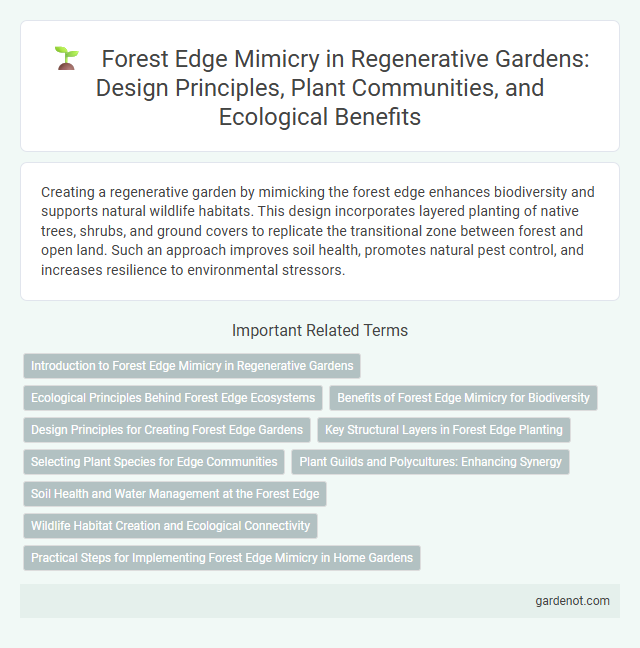Creating a regenerative garden by mimicking the forest edge enhances biodiversity and supports natural wildlife habitats. This design incorporates layered planting of native trees, shrubs, and ground covers to replicate the transitional zone between forest and open land. Such an approach improves soil health, promotes natural pest control, and increases resilience to environmental stressors.
Introduction to Forest Edge Mimicry in Regenerative Gardens
Forest edge mimicry in regenerative gardens harnesses the natural transition zones between dense forests and open landscapes to enhance biodiversity and soil health. By planting native shrubs, understory plants, and successional species that replicate these ecotones, gardeners create microhabitats supporting pollinators, wildlife, and nutrient cycling. This approach improves ecosystem resilience while promoting sustainable food production and water retention.
Ecological Principles Behind Forest Edge Ecosystems
Forest edge mimic in regenerative gardens replicates the unique ecological conditions found at natural forest boundaries, promoting biodiversity and soil health. These transitional zones support diverse plant and animal species by combining sunlight availability, moisture gradients, and nutrient cycling characteristic of forest edges. Incorporating layered vegetation structures mimics natural edge effects, enhancing microclimates and fostering resilient ecosystems.
Benefits of Forest Edge Mimicry for Biodiversity
Forest edge mimicry enhances biodiversity by creating transitional habitats that support diverse species unique to ecotones, increasing plant and animal variety. These zones provide critical resources such as shelter, food, and nesting sites for pollinators, birds, and small mammals, promoting ecological resilience. Incorporating forest edge structures in regenerative gardens fosters species interactions that boost ecosystem services like pest control, soil health, and nutrient cycling.
Design Principles for Creating Forest Edge Gardens
Forest edge mimic gardens prioritize layering plants to replicate natural ecotones where woodland meets open space, enhancing biodiversity and microclimate stability. Design principles emphasize selecting native species with varying heights and root structures to support wildlife corridors and soil health. Integrating transitional zones using shrubs, grasses, and pioneer trees fosters resilience and functional connectivity in regenerative landscapes.
Key Structural Layers in Forest Edge Planting
Forest edge mimic planting incorporates key structural layers such as tall canopy trees, mid-story shrubs, and low groundcover plants to recreate natural forest margins and enhance biodiversity. These layers optimize sunlight interception, soil stability, and habitat creation, promoting a resilient regenerative garden ecosystem. Integrating native species within each stratum ensures better adaptation and supports local wildlife effectively.
Selecting Plant Species for Edge Communities
Selecting plant species that thrive in forest edge environments is essential for creating resilient regenerative gardens. Native shrubs, grasses, and perennials adapted to varying light and moisture conditions promote biodiversity and soil health at the forest edge. Incorporating species such as elderberry, goldenrod, and switchgrass supports pollinators and creates natural habitat transitions.
Plant Guilds and Polycultures: Enhancing Synergy
Forest edge mimic leverages plant guilds and polycultures to replicate natural ecosystem dynamics, promoting biodiversity and soil health. Strategic combinations of complementary species enhance nutrient cycling, pest control, and microclimate regulation within regenerative gardens. This synergy fosters resilient plant communities that support long-term productivity and ecological balance.
Soil Health and Water Management at the Forest Edge
Forest edge mimic techniques enhance soil health by promoting organic matter accumulation and fostering diverse microbial communities critical for nutrient cycling. Water management at the forest edge involves capturing runoff through swales and mulch layering, improving soil moisture retention and reducing erosion. These practices create a resilient microhabitat that supports plant growth and sustains ecosystem functions in regenerative gardens.
Wildlife Habitat Creation and Ecological Connectivity
Forest edge mimic techniques in regenerative gardens enhance wildlife habitat creation by replicating natural ecotones where diverse species thrive. This approach strengthens ecological connectivity by providing corridors that support animal movement and genetic exchange between fragmented landscapes. Integrating native shrubs and understory plants maximizes biodiversity and fosters resilient ecosystems.
Practical Steps for Implementing Forest Edge Mimicry in Home Gardens
Implementing forest edge mimicry in home gardens requires selecting diverse native plant species that thrive in partial shade and varying soil conditions, replicating the natural gradient found at forest boundaries. Incorporate layers of vegetation, such as ground covers, shrubs, and small trees, to create microhabitats that support local wildlife and enhance biodiversity. Regular maintenance involves mulching to retain moisture, monitoring soil health, and minimizing chemical inputs to promote a self-sustaining, resilient ecosystem.
Forest edge mimic Infographic

 gardenot.com
gardenot.com